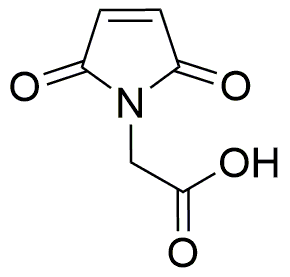2-Maleimidoacetic acid is widely utilized in research focused on:
- Bioconjugation: This compound is commonly used to link biomolecules, such as proteins and peptides, to other molecules for drug delivery systems, enhancing the efficacy of therapeutic agents.
- Diagnostic Applications: It plays a crucial role in the development of diagnostic tools, particularly in the creation of biosensors that detect specific biomolecules, aiding in early disease detection.
- Polymer Chemistry: In the field of polymer science, it is employed to modify polymer surfaces, improving their properties for applications in coatings and adhesives.
- Drug Development: Researchers utilize it in the synthesis of novel pharmaceuticals, particularly in creating compounds with improved bioavailability and targeted delivery mechanisms.
- Research in Cancer Therapy: It is being explored for its potential in targeted cancer therapies, allowing for the selective delivery of cytotoxic agents to cancer cells, minimizing damage to healthy tissues.
General Information
Properties
Safety and Regulations
Applications
2-Maleimidoacetic acid is widely utilized in research focused on:
- Bioconjugation: This compound is commonly used to link biomolecules, such as proteins and peptides, to other molecules for drug delivery systems, enhancing the efficacy of therapeutic agents.
- Diagnostic Applications: It plays a crucial role in the development of diagnostic tools, particularly in the creation of biosensors that detect specific biomolecules, aiding in early disease detection.
- Polymer Chemistry: In the field of polymer science, it is employed to modify polymer surfaces, improving their properties for applications in coatings and adhesives.
- Drug Development: Researchers utilize it in the synthesis of novel pharmaceuticals, particularly in creating compounds with improved bioavailability and targeted delivery mechanisms.
- Research in Cancer Therapy: It is being explored for its potential in targeted cancer therapies, allowing for the selective delivery of cytotoxic agents to cancer cells, minimizing damage to healthy tissues.
Documents
Safety Data Sheets (SDS)
The SDS provides comprehensive safety information on handling, storage, and disposal of the product.
Product Specification (PS)
The PS provides a comprehensive breakdown of the product’s properties, including chemical composition, physical state, purity, and storage requirements. It also details acceptable quality ranges and the product's intended applications.
Certificates of Analysis (COA)
Search for Certificates of Analysis (COA) by entering the products Lot Number. Lot and Batch Numbers can be found on a product’s label following the words ‘Lot’ or ‘Batch’.
Número de catálogo
Número de lote/lote
Certificates Of Origin (COO)
This COO confirms the country where the product was manufactured, and also details the materials and components used in it and whether it is derived from natural, synthetic, or other specific sources. This certificate may be required for customs, trade, and regulatory compliance.
Número de catálogo
Número de lote/lote
Safety Data Sheets (SDS)
The SDS provides comprehensive safety information on handling, storage, and disposal of the product.
DownloadProduct Specification (PS)
The PS provides a comprehensive breakdown of the product’s properties, including chemical composition, physical state, purity, and storage requirements. It also details acceptable quality ranges and the product's intended applications.
DownloadCertificates of Analysis (COA)
Search for Certificates of Analysis (COA) by entering the products Lot Number. Lot and Batch Numbers can be found on a product’s label following the words ‘Lot’ or ‘Batch’.
Número de catálogo
Número de lote/lote
Certificates Of Origin (COO)
This COO confirms the country where the product was manufactured, and also details the materials and components used in it and whether it is derived from natural, synthetic, or other specific sources. This certificate may be required for customs, trade, and regulatory compliance.


